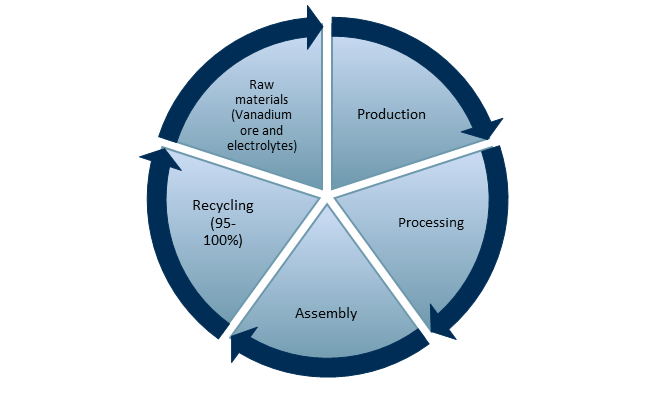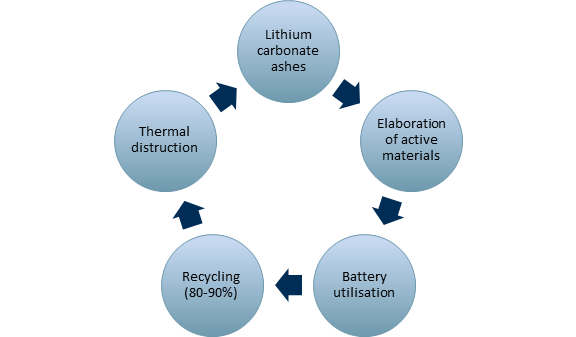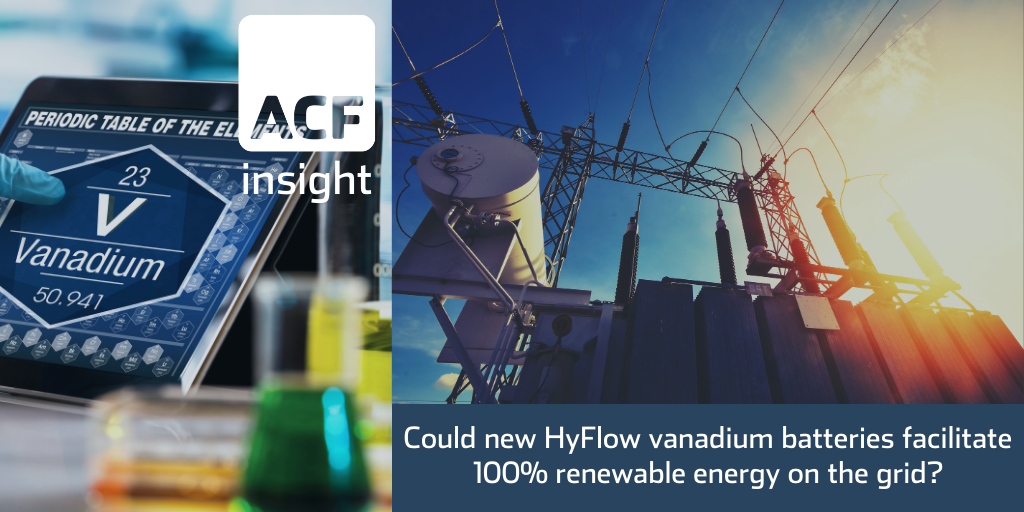Hybrid flow battery (VFB) – can skyrocket V demand
The Hyflow project aims to produce a hybrid vanadium flow (redox) battery (abbreviations VRB, VFB, VRFB) that has both high energy density…and a short charge cycle. The hybrid VFB is designed to help load-balance power grids. The project has received €4m from the EU to fund it out to 2023.
The research project is developed by scientists from 7 EU countries and 11 parties, including the Landshut University of Applied Sciences, along with the Fraunhofer Institute for Chemical Technology (ICT), the Karlsruhe Institute of Technology (KIT) and the Bavarian Research Alliance.
- The researchers’ plan is to combine a high-performance vanadium redox flow battery with a supercapacitor. This should create an energy storage system with both high storage capacity and high performance.
- A VFB is normally charged and discharged very slowly but has high energy density. The charging time of a supercapacitor is short with a low energy density. Supercapacitors are used when frequent short charge and discharge cycles at high current (high burst of power) are required e.g. in automobiles.
- Supercapacitors store energy as an electric field. Batteries store chemical energy and convert the chemical energy to electrical energy (e.g. solid-state Li-ion batteries). As such, supercapacitors do not lose their capacity to hold a charge, unlike chemical batteries.
The Hyflow VFRB is another potential innovation that suggests to us that the ‘gap’ between renewable energy production and renewable energy storage requirements for grid systems is, for all intent and purpose, all but bridged.
Standard Vanadium flow batteries work differently to solid state chemical batteries.
In a VFB, according to VanadiumCorp ($VRB.V $VRBFF : OTC), there are two liquids (each liquid is a different oxidation state of Vanadium in solution) stored in separate tanks. When these liquids are pumped past one another, separated by a membrane, they generate a charge by moving electrons in one direction for charging and the opposite direction for discharging.
In the exhibit below, we show Australian Vanadium ($AVL), Western Uranium ($WSTRF), Vanadiumcorp ($VRBFF), Vanadium Resources ($VRB) and Vanadium One ($VONE) that make up part of our peer group of vanadium miners that would benefit from increased demand for V as a result of a solution to the storage problem for renewable electricity generation that could make grids 100% fed by renewables.
Exhibit 1 – Vanadium miners peer group
 Source: ACF Equity Research; Refinitv
Source: ACF Equity Research; Refinitv
The downside of a standard VFRB is that it takes a long time to charge and can only discharge slowly. Grid systems need to be able to store energy indefinitely but release it very quickly at peak load.
This HyFlow hybrid version of the VFRB is positioned as an enhancement because of the addition of a supercapacitor, which allows the hybrid VFRB to deliver both high capacity, and high performance (fast discharge and recharge), according to Landshut University of Applied Sciences.
According to Largo Resources ($LGO:Nasdaq, $LGORF:OTC, $LGO.TO), a vertically integrated high grade vanadium miner, “vanadium flow battery systems show degradation after 10,000 cycles, which is the equivalent of over 26 years, if cycled daily” (Vanadiumprice, 2020).
Other sources suggest VFBs are durable for over 20-25k cycles. In any event, VFBs compare very favourably to solid-state batteries, which have 4-5k charge/discharge cycles. The levelized cost of energy (LCOE) also compares favourably to solid-state batteries. VFB LCOE is in the order of 10s of cents – much lower than solid-state batteries.
This again suggests to us that the industry and regulator target LCOE of 5 cents is within reach and that VFBs could bridge the storage challenge for renewable electricity.
Electrical grids require reliable consistent power generation – renewables as a source of 100% of grid electricity fail this test unless the energy from renewable generation can be stored cost effectively – The Hyflow hybrid VFB is another recent potential answer to this renewable electricity grid supply challenge.
“VRFB is intrinsically safe with no fire risk from thermal runaway (cf. solid-state Li-ion). Additionally, the contained vanadium electrolyte can be recycled for reuse in other VRFB instalments at the end of the battery life.” according to Largo Resources CEO Paulo Misk (Vanadiumprice, 2020).
Although recyclability is positive for the ‘E’ in ESG, it should be recalled by investors that vanadium (V) in the VFB electrolyte is dissolved in sulphuric acid, which comes with its own environmental risks.
The recycling efficiency of VFB components is assumed to be between 95-100% vs that of the lithium batteries at 80-90%. As per exhibit 2 and 3.
Exhibit 2 – Vanadium flow battery life cycle
 Source: ACF Equity Research Graphics; ScienceDirect
Source: ACF Equity Research Graphics; ScienceDirect
Exhibit 3 – Lithium-ion battery life cycle
 Sources: ACF Equity Research Graphics; ScienceDirect
Sources: ACF Equity Research Graphics; ScienceDirect
Author: Anda Onu – Anda is part of ACF’s Sales & Strategy team. See Anda’s profile here
















